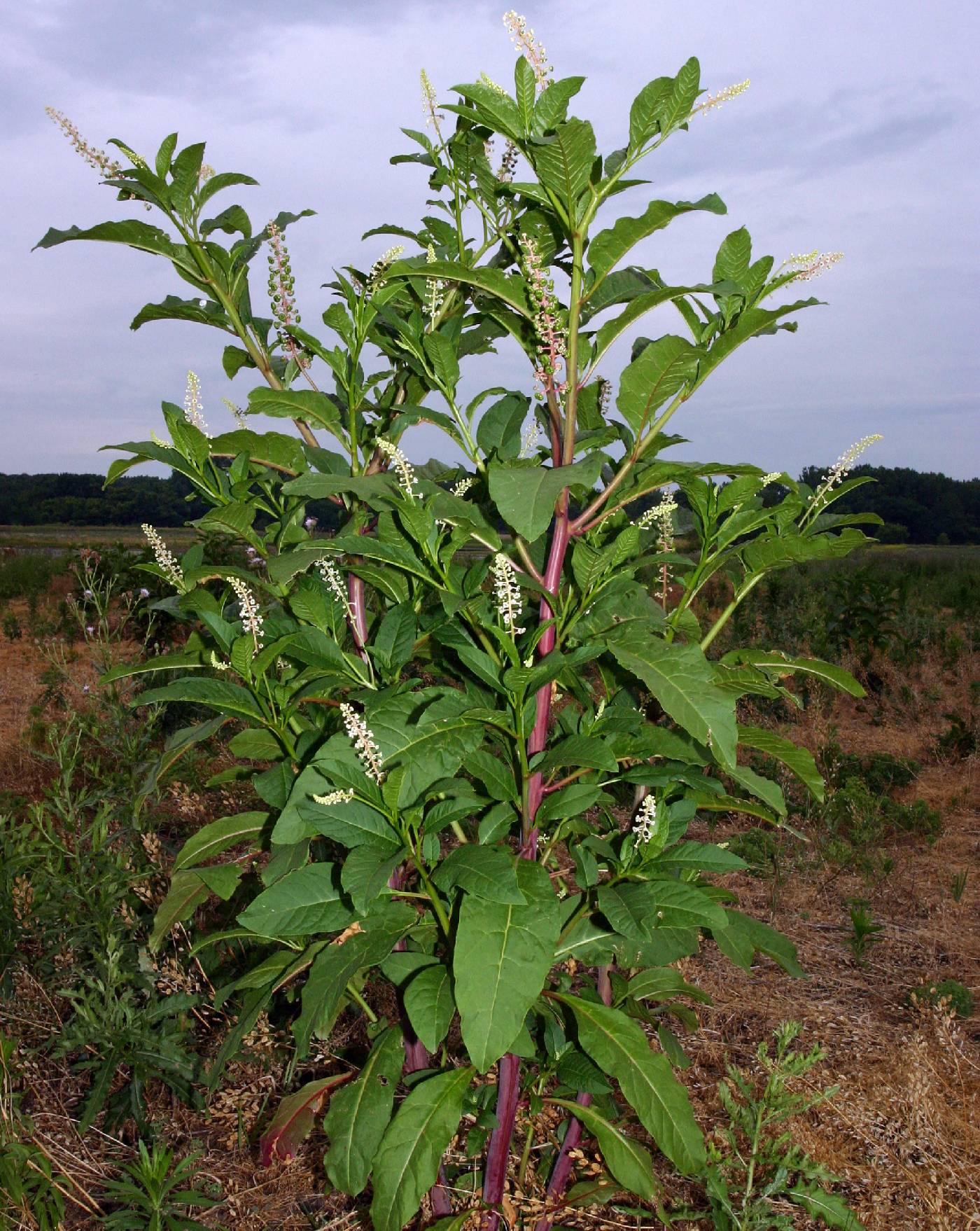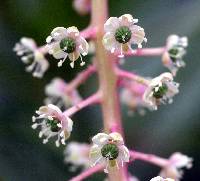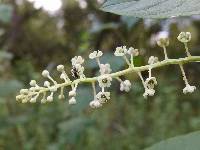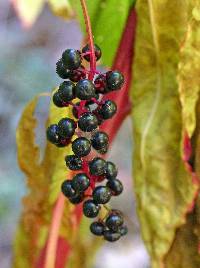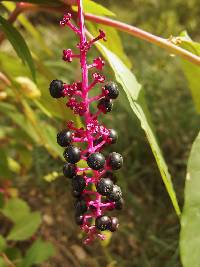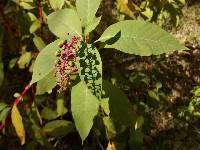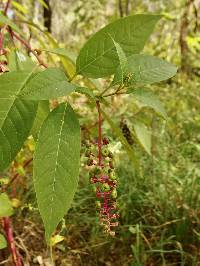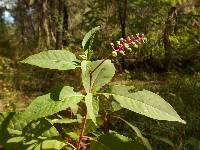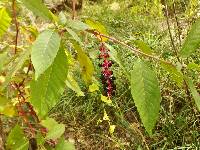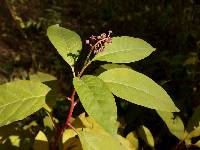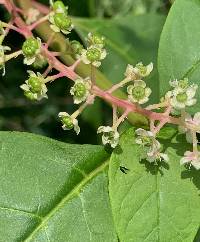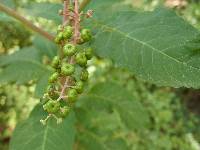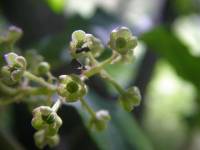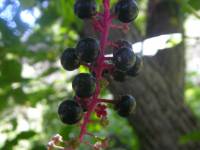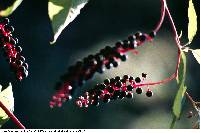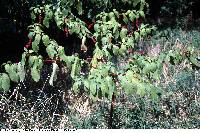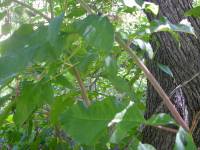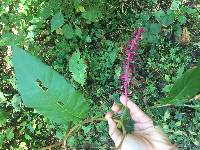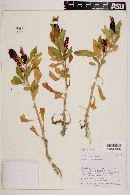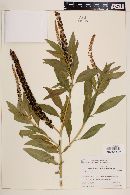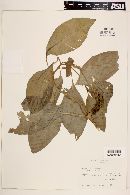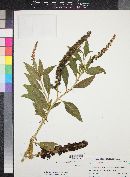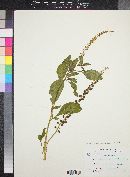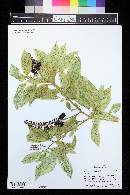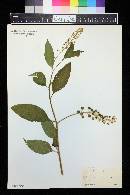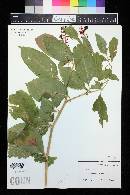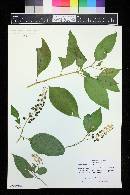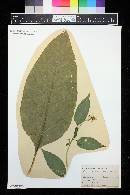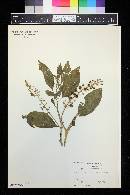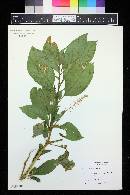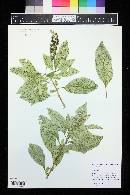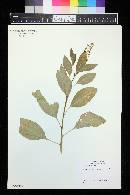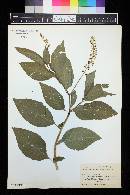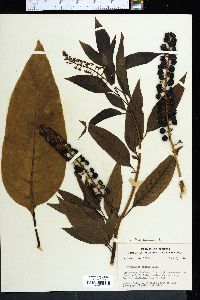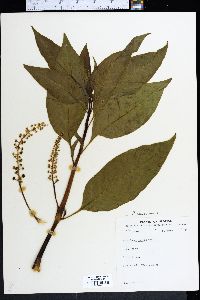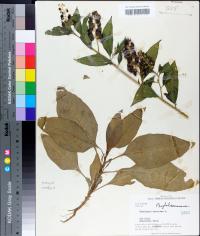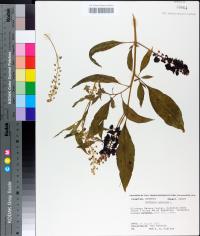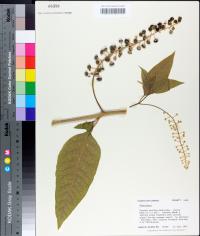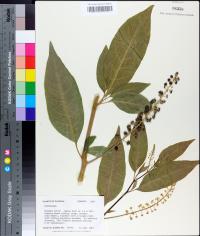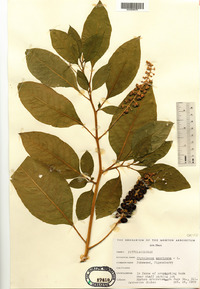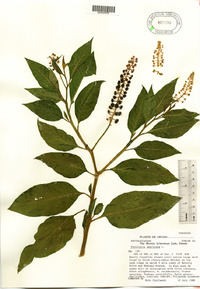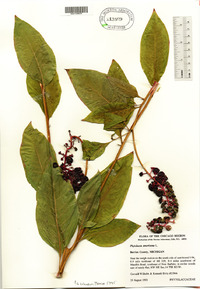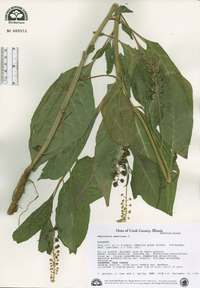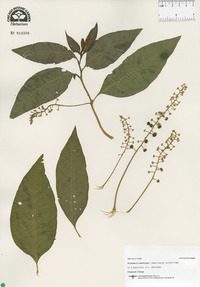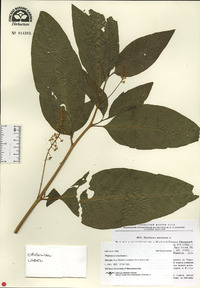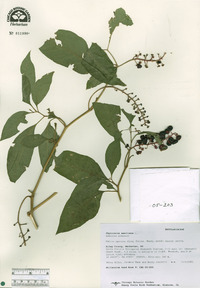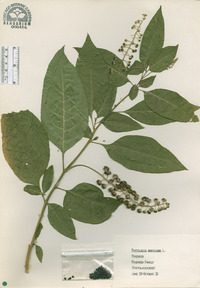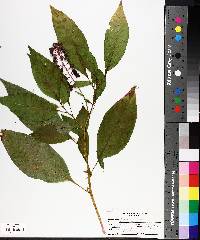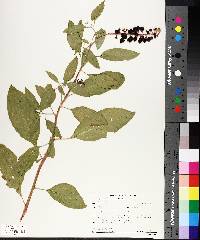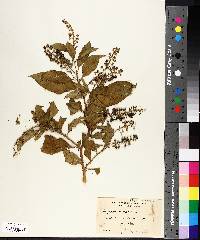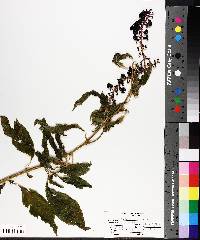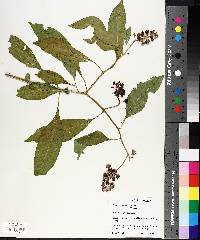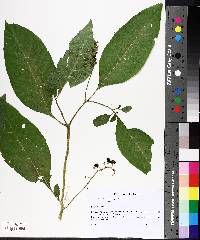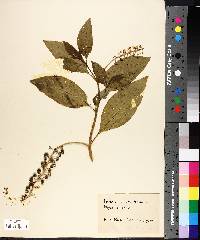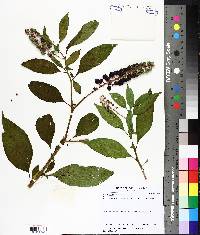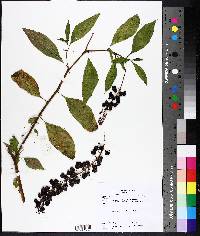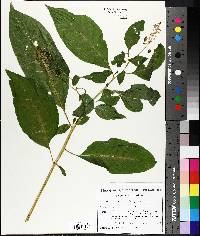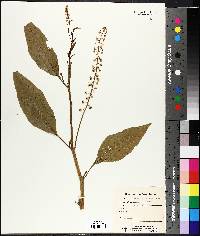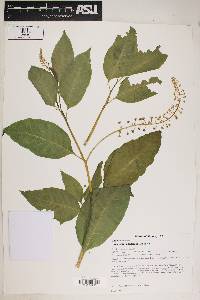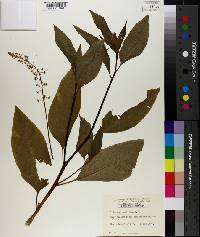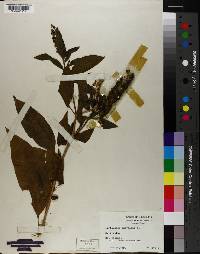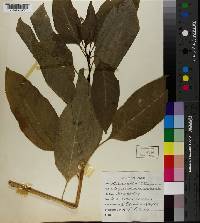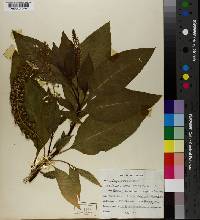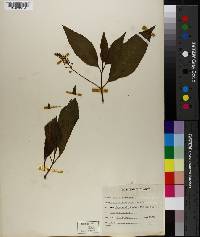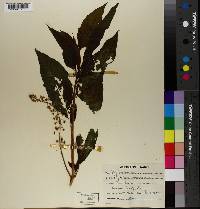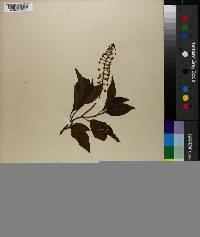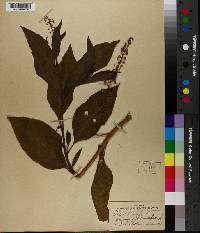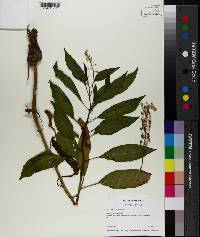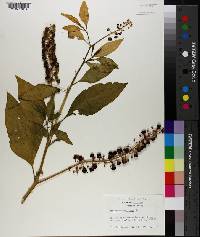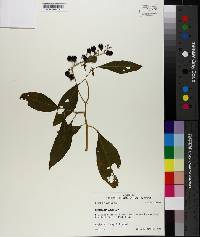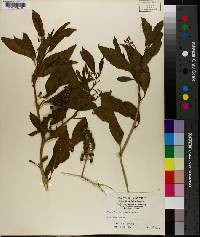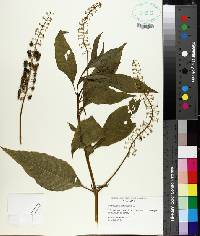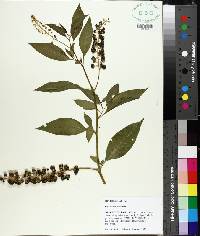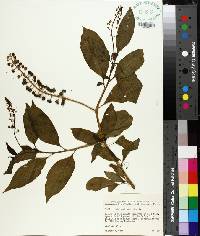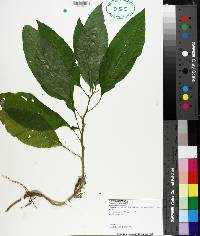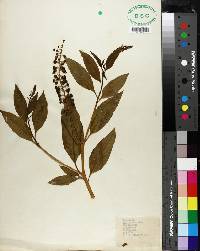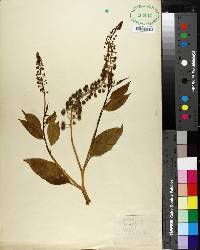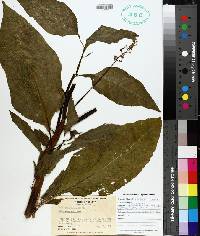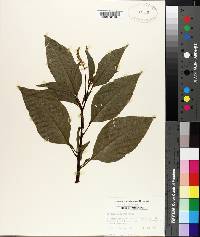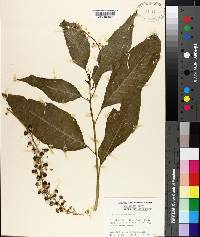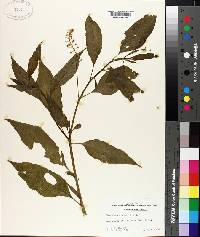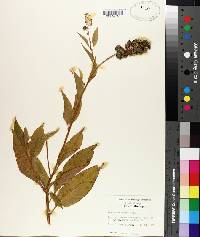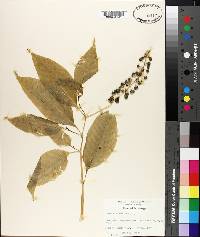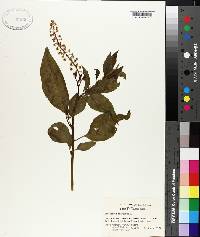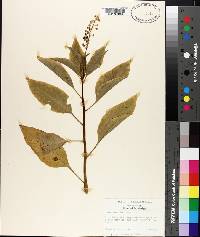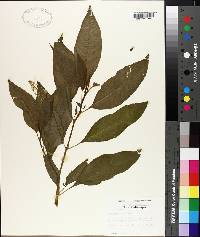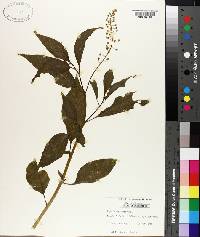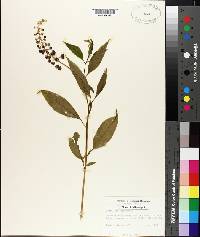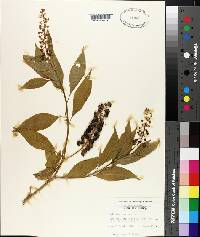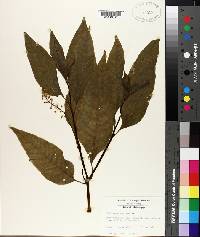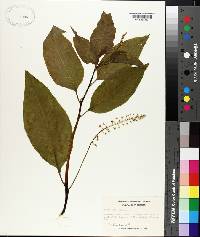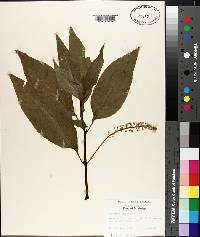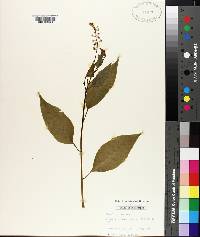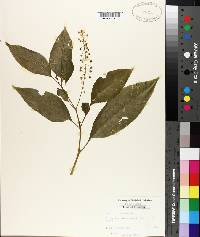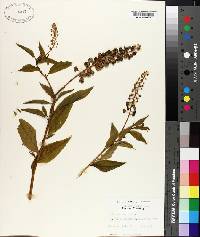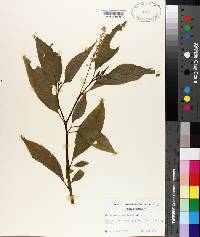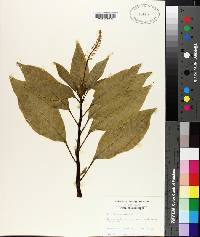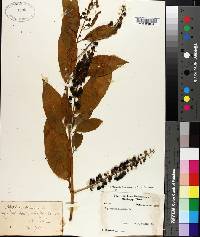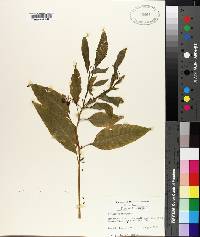Phytolacca americana
|
|
|
|
Family: Phytolaccaceae
American Pokeweed, more...poke-salad, poke-weed, common pokeweed, inkberry, pigeonberry, poke, pokeberry, pokeweed
[Phytolacca americana var. lancifolia H. Walter] |
Plants to 3(-7) m. Leaves: petiole 1-6 cm; blade lanceolate to ovate, to 35 × 18 cm, base rounded to cordate, apex acuminate. Racemes open, proximalmost pedicels sometimes bearing 2-few flowers, erect to drooping, 6-30 cm; peduncle to 15 cm; pedicel 3-13 mm. Flowers: sepals 5, white or greenish white to pinkish or purplish, ovate to suborbiculate, equal to subequal, 2.5-3.3 mm; stamens (9-)10(-12) in 1 whorl; carpels 6-12, connate at least in proximal 1/2; ovary 6-12-loculed. Berries purple-black, 6-11 mm diam. Seeds black, lenticular, 3 mm, shiny. 2n = 36. The infraspecific taxonomy of Phytolacca americana has been disputed since J. K. Small (1905) recognized P. rigida as distinct from P. americana on the basis of its 'permanently erect panicles' [sic] and 'pedicels...much shorter than the diameter of the berries.' J. W. Hardin (1964b) separated P. rigida from P. americana by the length of the raceme (2-12 cm in P. rigida, 5-30 cm in P. americana) and the thickness and diameter of the xylem center of the peduncle (70% greater thickness in P. rigida, 17% greater diameter in P. americana), but he found no discontinuities in any feature. J. W. Nowicke (1968) and J. D. Sauer (1952), among others, treated P. rigida as a synonym of P. americana. Most recently, D. B. Caulkins and R. Wyatt (1990) recognized P. rigida as a variety of P. americana. The varieties are not always clearly distinct. Some specimens combine the erect inflorescences of var. rigida with the long pedicels of var. americana. Such intermediate plants can be seen as far north as coastal Delaware, sometimes growing with var. americana. Collectors of Phytolacca americana should record carefully whether the inflorescences are erect, drooping, or intermediate between the extremes. The fruits and seeds of Phytolacca americana are eaten and disseminated by birds and, probably, mammals. They are said to be an important source of food for mourning doves (A. C. Martin et al. 1951). Phytolacca americana is well known to herbalists, cell biologists, and toxicologists. According to some accounts, its young leaves, after being boiled in two waters (the first being discarded) to deactivate toxins, are edible, even being available canned (they pose no culinary threat to spinach). Young shoots are eaten as a substitute for asparagus. Ripe berries were used to color wine and are eaten (cooked) in pies. Poke is used as an emetic, a purgative, a suppurative, a spring tonic, and a treatment for various skin maladies, especially hemorrhoids. Pokeweed mitogen is a mixture of glycoprotein lectins that are powerful immune stimulants, promoting T- and B-lymphocyte proliferation and increased immun-oglobulin levels. 'Accidental exposure to juices from Phytolacca americana via ingestion, breaks in the skin, and the conjunctiva has brought about hematological changes in numerous people, including researchers studying this species' (G. K. Rogers 1985). Poke antiviral proteins are of great interest for their broad, potent antiviral (including Human Immunodeficiency Virus) and antifungal properties (P. Wang et al. 1998). Saponins found in P. americana and P. dodecandra are lethal to the molluscan intermediate host of schistosomiasis (J. M. Pezzuto et al. 1984). The toxic compounds in P. americana are phytolaccatoxin and related triterpene saponins, the alkaloid phytolaccin, various histamines, and oxalic acid. When ingested, the roots, leaves, and fruits may poison animals, including Homo sapiens. Symptoms of poke poisoning include sweating, burning of the mouth and throat, severe gastritis, vomiting, bloody diarrhea, blurred vision, elevated white-blood-cell counts, unconsciousness, and, rarely, death. 'Poke' is thought to come from 'pocan' or 'puccoon,' prob Plant: perennial herb; 1-3 m high, mostly glabrous; stems somewhat succulent Leaves: petiolate, glabrous, the apices acute; 5-32 cm long, lanceolate, elliptic or ovate INFLORESCENCE: lax in fruit, 8-25 cm long, glabrous to puberulent Flowers: green, white, or pink; calyx 2-3 mm long; stamens (9-)10(-12); bracteate; calyx deeply lobed Fruit: berries, on pedicels 4 mm or more long; SEEDS lens-shaped, black and shiny Misc: Disturbed habitats; 1200-1600 m (4000-5300 ft); Jun-Nov REFERENCES: Steinmann, Victor. 2001. Phytolaccaceae. J. Ariz. - Nev. Acad. Sci. Volume 33(1). REFERENCES: Steinmann, Victor. 2001. Phytolaccaceae. J. Ariz. - Nev. Acad. Sci. Volume 33(1). Perennial herb to 3 m (rarely to 7 m) tall Stem: green to purple, branched. Leaves: stalked, to 35 cm tall, to 18 cm wide, lance- to egg-shaped with a rounded to heart-shaped base and pointed tip. Inflorescence: open and unbranched (raceme), 6 - 30 cm long, erect to drooping. Flowers: with five white to greenish white or pink to purple sepals, lacking petals, usually having ten stamens and six to twelve pistils fused from the base to at least the middle. Fruit: a purplish black berry 6 - 11 mm across. The shiny black seeds are 3 mm across and lens-shaped with convex faces. Similar species: No information at this time. Flowering: late June to mid October Habitat and ecology: This species can be weedy in disturbed habitats such as heavily trampled woodlands, shaded disturbed roadsides, and floodplains lacking permanent vegetation. It prefers rich soil but can grow in clay or sand with minimal competition. Occurence in the Chicago region: native Notes: This plant has many toxic compounds including phytolaccatoxin, saponins, phytolaccin, and oxalic acid. The roots, leaves and fruits of this plant are highly poisonous and can be fatal. A number of glycoprotein lectins found in this species stimulate the immune system and are being studied for their antiviral and antifungal properties. Etymology: Phytolacca comes from the Greek word phyton, meaning plant, and the middle Latin word lacca, meaning crimson-lake, referring to the crimson color of the berries. Americana means "of America." Author: The Morton Arboretum FNA 2004, Steinman 2001, Jepson 1993, Kearney and Peebles 1969 Duration: Perennial Nativity: Native Lifeform: Forb/Herb General: Stems tall, branching, juicy, bright green, glabrous, ill-smelling. Leaves: Large, ovate-lanceolate, 5-32 cm long, acute or acuminate at base and tips. Flowers: Small, with 5 petal-like sepals, sepals red, white, or pinkish, borne in terminal racemes, appearing opposite the leaves, calyxes deeply lobed, stamens many, styles and stigmas several, styles recurved. Fruits: Fruit juicy, globose berries, dark purple to black at maturity, bright red when young. Seeds black and shiny, lens-shaped. Ecology: Found in disturbed areas from 4,000-6,000 ft (1219-1829 m); flowering July-November. Notes: There is some dispute as to the intraspecific taxonomy between Phytolacca americana and P. rigida. Note specifically that some consider this plant poisonous. Ethnobotany: Infusion berries and roots taken for arthritis, rheumatism and swellings, the root used for eczema, sores, taken internally for kidneys, used as a laxative, berries used for other general medicine, used as a blood purifier, as a stimulant, a cathartic, for chest colds, bruises, for liver sickness, used as a love medicine, and taken for swollen joins and sprains. Some used the greens as food, as well as the young stalks and shoots were cooked and eaten, along with dyes, and the berries were used to make jewelry. Etymology: Phytolacca is from Greek phyton for plant and the Latin lacca, crimson lake for the berry color, while americana means of or from America. Synonyms: Phytolacca decandra Editor: LCrumbacher, 2011 Coarse, glabrous, perennial herb to 3 m, branching above; lvs lance- oblong to ovate, 1-3 dm, on petioles 1-5 cm; racemes 1-2 dm, pedunculate, nodding in fr; fls perfect, greenish-white or pinkish, 6 mm wide; stamens and carpels usually each 10; carpels united except for the styles; berry depressed-globose, juicy, dark purple, 1 cm thick; 2n=36. Fields, fence-rows, and damp woods; Me. to Minn., s. to the Gulf of Mexico. July-Sept. (P. decandra) Gleason, Henry A. & Cronquist, Arthur J. 1991. Manual of vascular plants of northeastern United States and adjacent Canada. lxxv + 910 pp. ©The New York Botanical Garden. All rights reserved. Used by permission. |
|
|
|

